It is often said that everything is bigger in Australia, which is undoubtedly the case for their native bird species.
From pelicans to emus, many birds in Australia have long necks and large beaks. They are certainly not to be messed with. Here are 10 of the largest birds in Australia.
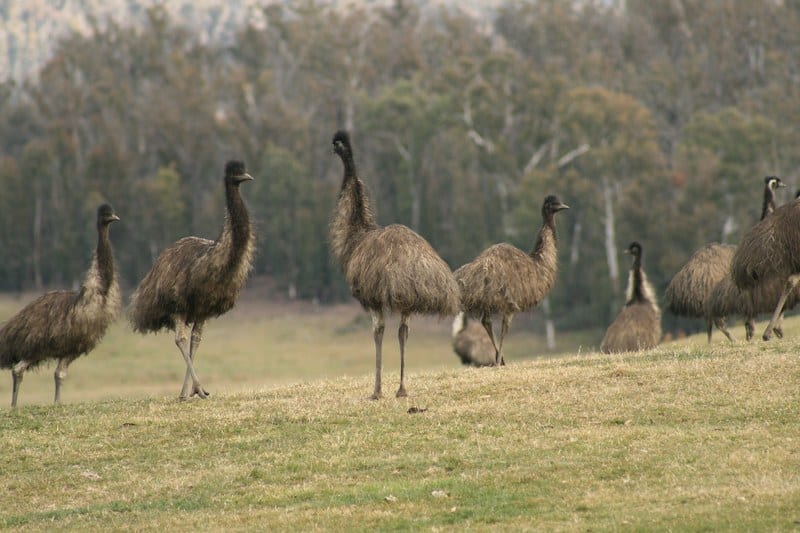
Emu
At the top of the list is the emu, a tall and imposing cousin of the Ostrich. The emu is the last living species of the genus Dromaius, including the Tasmanian emu and King Island emu.
Emus are resilient, incredibly fast, flightless birds. A male will dance to attract a female, and if she accepts him, she will join in the dance. The male incubates the egg and cares for the chick. Unlike most other animal species, males experience hormonal changes.
In 1932, Western Australia saw a war between emus and local farmers, many ex-military. The emus had devoured most of the farm’s crops, so the military was called to cull the growing population.
Today, emus inhabit most regions in Australia except for Tasmania. They keep mostly to uninhabited areas, but they still wander close to urban areas searching for food and water during times of drought.
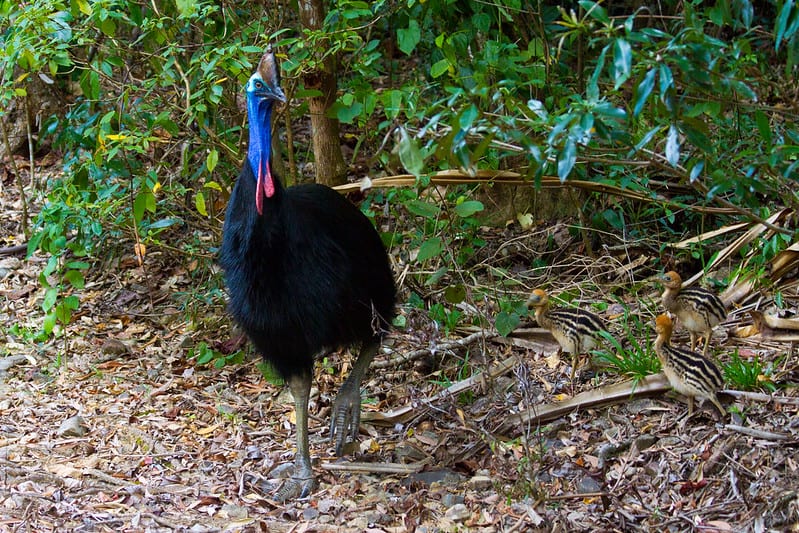
Cassowary
A close second on this list, the cassowary is roughly the same size as an emu but more striking in appearance and prefers tropical rainforests over grasslands or scrub.
Adults grow up to 1.8m tall. They have stockier legs than emus, with a large body covered in thin, bushy black feathers that resemble hair. Their necks are shorter than emus, but they have a bizarre horn reaching from the centre of their beak to the back of their head. The neck is bright blue, with vivid red wattles and large orange/amber eyes.
Cassowaries are solitary birds, interacting only to breed. As with emus, cassowary males do all the parenting, caring for the chicks for 8-9 months.
Find out what the most dangerous animals in Australia are in this article I wrote.
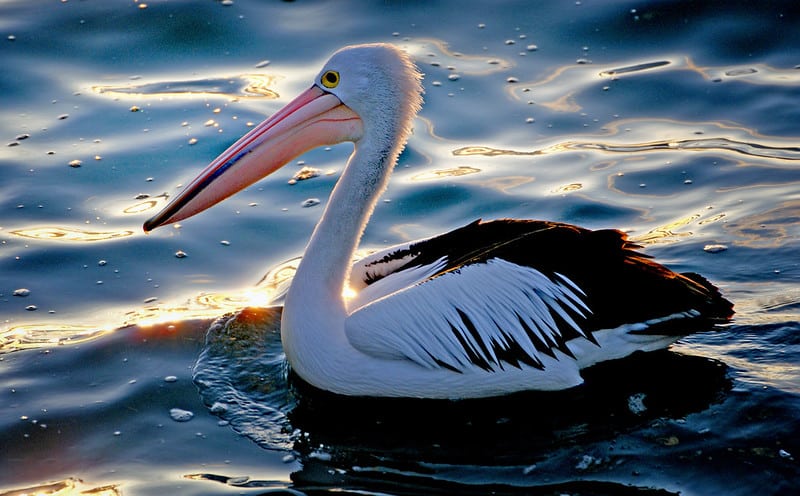
Bernard Spragg. NZ Flickr
Pelican
Australian pelicans are considered medium-sized birds. However, they have an impressive wingspan of 2.3 – 2.5 metres. These beautiful birds have short legs like a swan, with heavy-set bodies covered with black and white plumage.
The real wow of a pelican is their great beaks. An adult pelican’s beak is approximately 12in long from head to tip. They have a throat pouch extending below their beak that stretches to accommodate up to 3 times more fish than can fit in their stomach.
Being water birds, pelicans have thick plumage to repel water and large webbed feet that provides propulsion for swimming. They open their beaks and dive towards the water surface, filling their pouch with water and fish when feeding. They then force the water out.
Pelicans prefer coastal areas, wetlands, and natural lakes. They are well known for waiting near fishing harbours to accept fish from fishermen or try to steal them from boats.
Find out what the ten largest animals in South America are in this article I wrote.
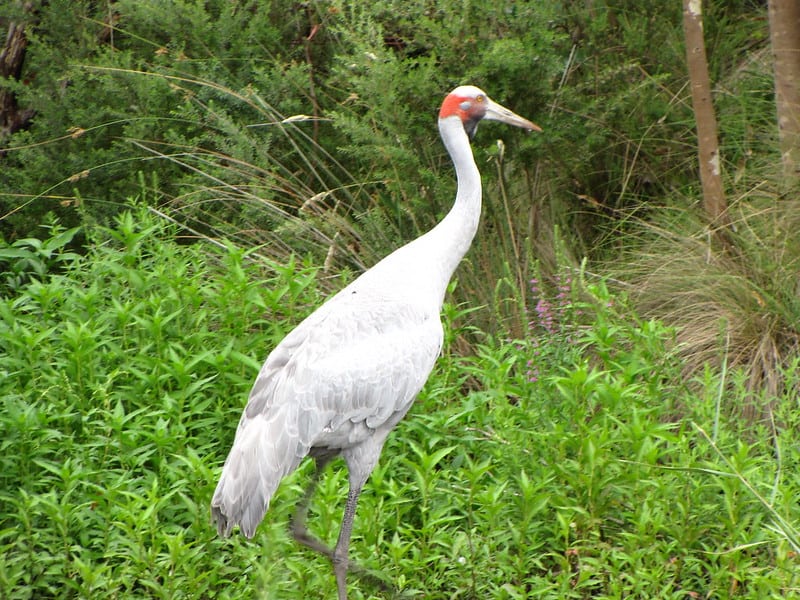
Brolga
Edged out for 3rd place is the brolga. They are roughly the same size as pelicans, with a wingspan of 2 – 2.3m. However, brolgas are slender, with grey feathers, plumage, and a red featherless head.
They are found across Australia, but they prefer desert to the lush rainforest or wetland marshes. They are also located near farmland, feeding on insects unearthed by farm crop machinery.
Brolgas have an elaborate and specific courtship ritual. They start by picking up, throwing, and catching tufts of grass. They then begin a complex and elegant dance, both on land and in the air. Finally, both adults incubate the egg clutch and care for the chicks.
Are Birds Vertebrates? The Class That Takes Flight

Black-necked Stork
Identical in height and similar in build to brolgas, black-necked storks are tall and elegant, standing at 1.3m. They have back and white body feathers, with a beautiful iridescent green-blue neck and head.
Also known as jabiru, black-necked storks are the only stork species native to Australia. Females have bright yellow eyes, while males have muted brown eyes.
These striking birds are waders, standing in shallow water to catch fish, crustaceans, amphibians, and smaller birds. They use their long, sharp beak to impale and then eat their prey.
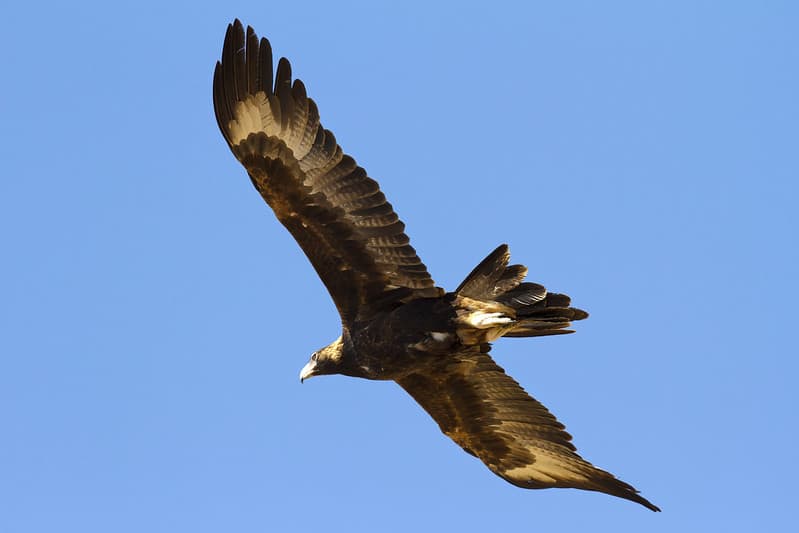
Wedge-tailed Eagle
While it may be smaller in height than some other birds on this list, this magnificent flier has a wingspan of 2.3m and is the largest bird of prey in Australia.
As the name suggests, this bird has a large wedge-shaped tail and strong, feathered legs and sharp talons on its feet for catching prey.
Wedge tails are carnivorous, hunting smaller birds, rodents, reptiles, and amphibians. They also feed on roadkill or carcasses of animals killed by other predators.
Wedge-tailed eagles have no natural predators themselves, and as such, their population is thriving, with just over 2 million estimated across Australia.
Their breeding behaviour is similar to other birds of prey. Wedge tails mate for life, only seeking a new partner if one of the pair dies. Breeding pairs will aggressively defend their nest and have been known to attack hang gliders, parachutes, and even helicopters.
Find out what the ten largest birds in South America are in this article I wrote.
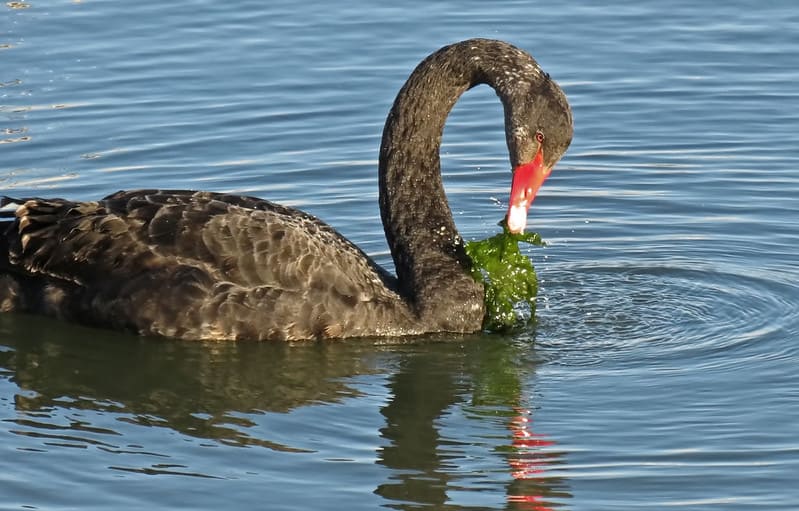
Australian Swan
Australian swans are hard to miss with jet black plumage, a bright red-orange beak, and flaming red eyes. Australian swans have short legs, webbed feet, stocky bodies, and long, slender necks like their European cousins.
They have an impressive wingspan for their size, at 1.6 – 2m. In flight, their wingtips can be seen, bright white in contrast to their body. They are graceful fliers but take a while to get airborne. Signets (chicks) are fluffy and grey, typically in a clutch of 5 to 10.
Breeding swans mate for life, with both adults sharing incubation of the eggs. Nests are constructed of mosses, reeds, and grasses on a small island or sometimes floating in wading deep water.
Do you know what the ten most dangerous animals in Australia are? Find out here
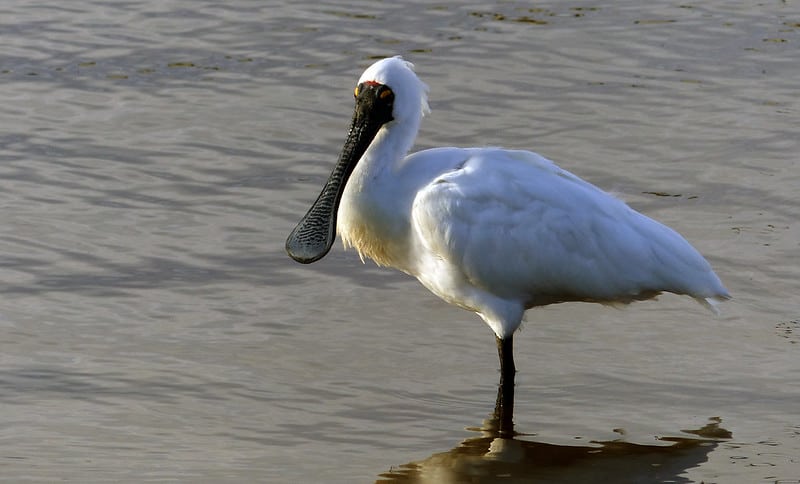
Royal Spoonbill
Perhaps the most unusual looking bird on this list, royal spoonbills are medium-sized birds, standing around 0.8 – 0.9m tall with a wingspan of 1.2 – 1.3m.
They have white feathers covering their body, with long black legs and a black face. The most bizarre part of the bird is its bill. However, the name is pretty accurate since the bill is long and ends with a rounded flat tip resembling a spoon.
During the breeding season, royal spoonbills sport long feathers from the back of their heads, which are displayed upright like a crown.
Spoonbills are wading birds living in regions with wetlands, marshes, and lakes. They are most common along the east coast, but scattered populations can also be found in western Australia.
Spoonbills feed in freshwater, hunting for shrimp and fish. They use their flat bills to sweep the water or substrate. They then lift their bills upwards so their prey slides easily into their throat.
The ten largest animals of South America can be found here.
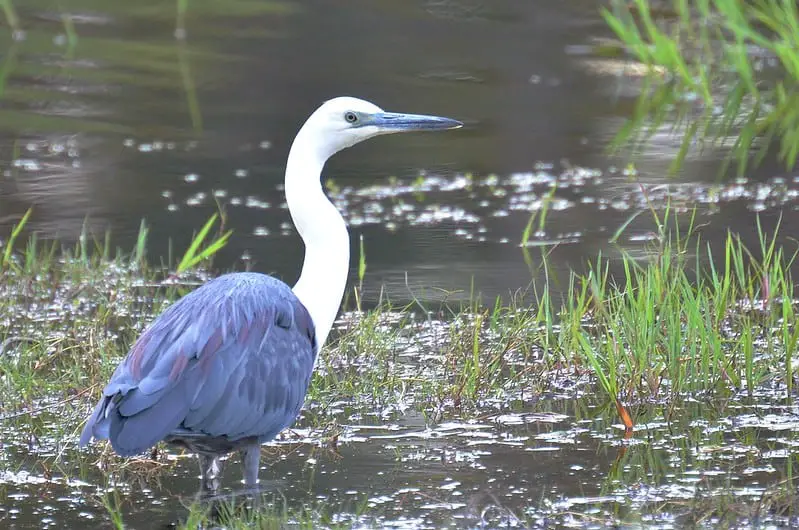
White-necked Heron
White-necked herons are serene, elegant birds that are related to cranes. They have long white necks with scattered black spots down the front of the neck. These spots disappear during the breeding season.
The body and wings are covered with dark grey plumage, and during the breeding season, maroon feathers also develop along the back.
White-necked herons stand around 1m tall with a wingspan of 1.4 – 1.6m. they are a migratory species, travelling between breeding and feeding habitats.
Some nesting regions are occupied year-round, whereas others are visited only for breeding. As a result, herons can quickly establish a feeding area where conditions are suitable. They tend to breed between September and December but will produce throughout the year, particularly after heavy rainfall.
Are Birds Vertebrates? The Class That Takes Flight
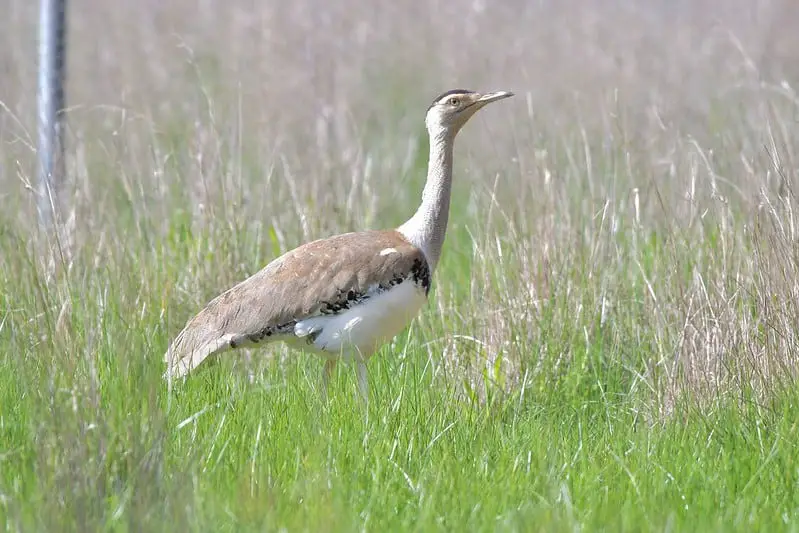
Australian Bustard
Last but certainly not least is the Australian bustard. Standing up to 1.2m tall with a wingspan of 2 – 2.3m, this leggy bird is beautiful and elegant.
Bustards have a large greyish/brown body with black and white feathers and wingtips. They have long legs and large feet, similar to emus and cassowary. They will walk away slowly when startled or threatened, holding firm eye contact.
Populations are spread throughout Australia, but most are found in the north. Bustards are nomadic like cranes and herons, travelling between established breeding and feeding grounds.
Bustards are omnivores, feeding on both vegetation and live prey. They will forage berries, fruits, leaves, small reptiles, and insects. Most feeding occurs from dusk and throughout the night.
During the breeding season, males will display to females by inflating their throat sacs and producing loud calls. Females lay a single green egg on the ground, and she incubates the egg for approximately 23 days.
While it is true that many of Australia’s birds are large and intimidating, most are beautiful, elegant, and serene. Colour, behaviour, and breeding patterns are abundant among Australia’s bird species, with birdwatchers having something to see throughout the year.
